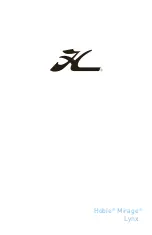
and clay or in hard sand. A lightweight Danforth anchor is
recommended for general boating. For more information
on anchors, see your dealer.
Make sure the line is tied to the anchor and tie the other
end of the line to the bow lifting eye.
Head the boat into the wind or current over the spot where
you want to lower the anchor.
Stop the boat before lowering the anchor.
When the anchor hits bottom, slowly back up the boat,
keeping tension on the line. Let out an anchor line that is
four to six times the depth of the water. For example, if you
are in 10 ft (3 m) of water, let out 40 to 60 ft (12 to 18 m)
of line.
Secure anchor line to the bow-lifting eye. Pull on line to
make sure anchor is holding.
Occasionally check your position against the shoreline. If
the anchor is dragging and you are drifting, reset the anchor.
Weighing (Pulling In) Anchor
Start engine and move forward until anchor line is straight
up and down.
Pull hard to lift anchor from the bottom material.
OPERATION
SECTION 4
4-23
If the anchor is stuck, allow the up and down motion of
the bow from wave action to loosen the anchor from the
bottom. If the anchor remains stuck, slowly maneuver the
boat around the anchor until the anchor pulls loose. Be
sure to keep the line tight during this procedure.
PERFORMANCE BOATING
Some boat models, especially those with high horsepower
engines, are capable of truly exhilarating performance. Do
not be tempted to push your boat to its limits until you are
completely familiar with the boat’s operating characteristics.
The operator should have at least 10 hours of experience
with the boat before any extended full throttle operation.
Here are some guidelines for performance operation. Read
and practice them, and soon you will be operating your
boat to its full capability.
Before Running
Keep the bottom clean and free of scum, barnacles and
other growth. Growth on the hull can slow the boat
down considerably.
Prepare the boat. Be sure all gear is properly stowed and
compartments are latched.
Keep weight in the boat low and evenly distributed.
Remove unnecessary weight and keep it onshore. Weight
distribution affects performance.
The propeller should be of the proper pitch to turn the
recommended RPM rating for the engine and of the proper
type for your average load and individual requirements.
Your Tigé boat is already equipped with the proper propeller
to achieve maximum performance with an average load for
your boat. If you have questions, see your Tigé Dealer.
4-24
Содержание 2015 ASR
Страница 1: ...2015 OWNER MANUAL ...
Страница 4: ...SECTION 1 ...
Страница 14: ...INTRODUCTION 1 19 SECTION 1 EUROPEAN SEATING CHART 1 20 ...
Страница 15: ...1 21 1 22 ...
Страница 16: ...1 23 1 24 ...
Страница 17: ...SECTION 2 ...
Страница 46: ...SECTION 3 ...
Страница 60: ...SECTION 4 ...
Страница 74: ...SECTION 5 ...
Страница 80: ...BOAT SYSTEMS SECTION 5 5 11 5 12 ...
Страница 81: ...SECTION 6 ...
Страница 96: ...TROUBLESHOOTING SERVICE REQUIREMENTS SECTION 7 ...
Страница 98: ...TROUBLESHOOTING SERVICE REQUIREMENTS SECTION 7 7 3 7 4 ...
Страница 99: ...TROUBLESHOOTING SERVICE REQUIREMENTS SECTION 7 7 5 7 6 ...
Страница 100: ...TROUBLESHOOTING SERVICE REQUIREMENTS SECTION 7 7 7 7 8 ...
Страница 101: ...TROUBLESHOOTING SERVICE REQUIREMENTS SECTION 7 7 9 7 10 ...
Страница 102: ...TROUBLESHOOTING SERVICE REQUIREMENTS SECTION 7 7 11 7 12 ...
Страница 103: ...TROUBLESHOOTING SERVICE REQUIREMENTS SECTION 7 7 13 ...
Страница 104: ...WARNING LABELS SECTION 8 ...
Страница 107: ...WARNING LABELS SECTION 8 8 5 8 6 ...
Страница 108: ...WARNING LABELS SECTION 8 8 7 8 8 ...
Страница 109: ...WARNING LABELS SECTION 8 8 9 8 10 ...
Страница 110: ...WARNING LABELS SECTION 8 8 11 8 12 ...
Страница 111: ...WARNING LABELS SECTION 8 8 13 8 14 GOOD BAD ...
















































